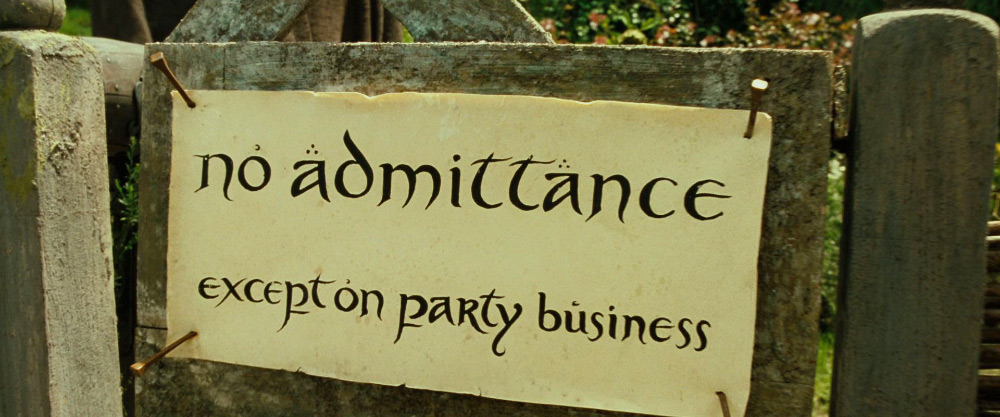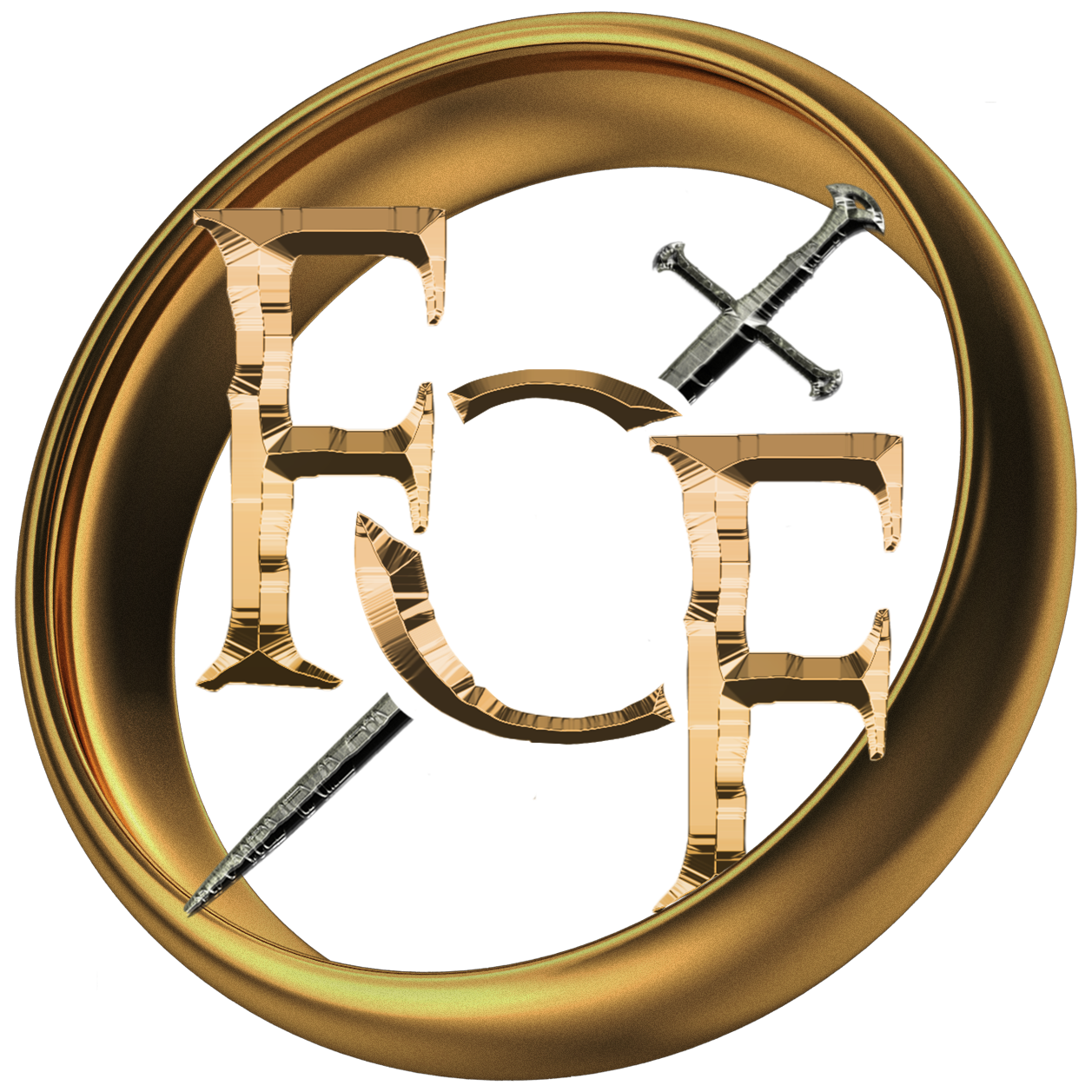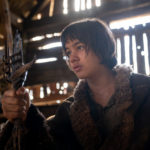
Translation Conventions in Tolkien and Tolkien Adaptations
The past is a foreign country.
—L. P. Hartley
My corollary to this rather well-known quote is: “The past is a foreign language,” and I like it well enough that sometimes I forget it was not the original quote. When watching films and television shows set in England during the Middle Ages, we are used to characters speaking Modern British English sprinkled with a few archaicisms, rather than Middle English. Even when characters from the present time travel to the Middle Ages, they almost invariably pick up the language with no difficulty, apart perhaps from stumbling over some of those aforementioned archaicisms. But even in media that are not set in Britain or its colonies in the past millennium, it is still usually seen as necessary to use Modern English if the intended audience is English speaking. In Star Trek, Federation citizens speak Modern English just as it was spoken in the 20th and 21st centuries, and for those aliens who could not be expected to know English, the Universal Translator always converts their native language into fluent English, except on the few occasions when the writers wish to showcase an alien form of communication. In Star Wars—especially the Original Trilogy films—aliens and droids have their own forms of communication, but “humans” mostly all speak the same language, Galactic Basic, which either just happens to be identical to Modern English (albeit with a different writing system), or more likely has been translated into Modern English for our convenience. This latter case, at least, is an example of a “translation convention“, assuming Galactic Basic is not coincidentally identical to English. (CAUTION: link goes to TV Tropes, which has been known to aggravate cases of Internet addiction.) Translation conventions are necessary when creating stories that take place in a time or place where people do not speak the language of the intended audience, or often, of the actors as well.
Tolkien’s Translation Conventions
J.R.R. Tolkien, who was quite familiar with the Ancient and Medieval worlds, employed a conscious—and somewhat complicated—translation convention when writing The Lord of the Rings. He was less conscious—or at least less decided—when writing The Hobbit, which necessitated some of that complexity. The works of Tolkien’s Legendarium are set on our own Earth, but in a time far before the development of Modern English, or of any form of what could be called English. For this reason, Tolkien adopted the conceit that the works had been translated into Modern English. Yet they contain numerous words, phrases, and even larger passages and poems, in several different languages. So what, exactly, has been “translated”, and what has not? As far as Tolkien is concerned, the answer to this question is quite simple: everything that was in Westron in the original was “translated” into Modern English. Other languages were either kept as they were, or converted to a language related to English, where the language was noticeably similar to Westron. So, the Elvish languages, notably Quenya and Sindarin, are kept as is; as well as Khuzdul, the Dwarvish language; Old Entish; the Black Speech of Mordor, and a “debased” Orcish variant thereof; as well as a handful of words in the languages of the Dunlendings, the Woses, and the Haradrim.
For the Mannish languages of the Westlands of Middle-earth, things are rather more complex. According to Tolkien’s translation convention, the point-of-view language of The Hobbit and The Lord of the Rings is Westron, also known as the Common Speech. Westron is a descendant of Adûnaic, the language spoken by two Houses of the Edain (Men who were friendly with the Elves) in the First Age, and by the majority of Númenóreans (descendants of the Edain) in the Second Age. As the Númenóreans settled the coasts of Middle-earth in the latter Second Age, their language spread. Westron is derived from the Adûnaic spoken in the port city of Pelargir, a haven of the Faithful (to the Valar and the Elves) Númenóreans that became a major city of the Kingdom of Gondor. This language became the lingua franca of the Westlands, spoken in all of Arnor and Gondor, and widely spoken in Rhovanion as well. Even Orcs of different tribes often used it as a lingua franca. Tolkien comments briefly on Westron, and what it “really” looked like in Appendix F of The Lord of the Rings, but within the narrative it is represented only by Modern English, to the point that even the non-Khuzdul part of the inscription on Balin’s tomb is in Modern English, rather than in “actual” Westron, written in Cirth (runes).
The complexity of Tolkien’s translation convention is most apparent in the Mannish languages which are related to Westron. In The Hobbit, which was originally a private story only intended for the amusement of his children, Tolkien used names from the Old Norse Dvergatal for most of his Dwarves, as well as for Gandalf. The period during which Old Norse was spoken (ca. A.D. 700-1400) coincides roughly with the Middle Ages. Possibly he originally intended for The Hobbit to take place some time during the Middle Ages. However, as he developed his sequel to The Hobbit, and figured out when it should take place relative to his existing Legendarium, it became apparent that Old Norse names would be anachronisms in the Third Age during which these works are set. So Tolkien hit upon a clever solution: the Northmen of Rhovanion (called “Wilderland” in The Hobbit) were related to one of the Houses of the Edain, and spoke a language related to Adûnaic, and therefore to Westron. Therefore, their languages are represented by Germanic languages which are similarly related to Modern English. The language of Dale and Laketown (also spoken by the Dwarves of the Lonely Mountain) is represented by Old Norse. The language of the Kingdom of Rhovanion in the mid-Third Age is represented by Gothic. The language spoken by the inhabitants of the Vales of Anduin, including Beorn, Sméagol (Gollum), and the Éothéod (ancestors of the Rohirrim), is represented by Old English. And the language spoken by the Éothéod around the time of the fall of the Kingdom of Rhovanion seems to be a hypothetical ancestor of Old English, such as Proto-West Germanic, or North Sea Germanic (Ingvaeonic). The Hobbits, living in what once was the Kingdom of Arnor, speak Modern English (Westron), but having migrated from the Vales of Anduin, they have retained some archaicisms that show their connection to the “Old English” spoken there.
Tolkien’s translation conventions were not limited to Germanic languages. There is clear Celtic influence in names from Buckland and Bree. The Men of Bree-land migrated from the south during the Dark Years of the Second Age, and were presumably related to the Dunlendings and the Men of the Mountains, who became the Dead Men of Dunharrow. The Bucklanders were largely made up of Stoors, a tribe of Hobbits that had lived on the borders of Dunland before migrating to Buckland. Presumably their tendency to use Celtic given names (such as “Meriadoc”) is reflective of that fact. There are even indications that Tolkien may have used Latin to represent one of the languages of Gondor, although he ultimately thought better of it.
Translation Conventions in Adaptations of Tolkien’s Works
Any adaptation of Tolkien’s works is likely to use a translation convention, given that few, if any, of the actors involved are likely to be native speakers of Quenya, Sindarin, Khuzdul, or any of Tolkien’s other invented languages. Instead, they are likely to speak Modern English (or some other modern language), just as Tolkien’s written works and translations thereof. Below I will describe the translation conventions used in the live-action films produced by New Line Cinema, as well as potential translation conventions that may be used in the upcoming adaptations of Tolkien’s works, The War of the Rohirrim and The Rings of Power.
The Lord of the Rings and The Hobbit (New Line Cinema)
At the beginning of this millennium New Line Cinema produced six live-action films based on The Lord of the Rings and The Hobbit, all directed by Peter Jackson and filmed almost entirely in New Zealand. The dialog was delivered mostly in Modern English. In The Lord of the Rings trilogy, characters speak Modern English when they are speaking Westron, and also when they are speaking to other native speakers of their language. Thus Arwen speaks Sindarin when she spurs her horse on in the presence of the Hobbits, but when she is alone with Elrond they speak English, rather than Sindarin, as one would expect. Likewise, Sauron’s forces from Mordor speak to each other in English, rather than in the Black Speech. In The Hobbit trilogy, however, Modern English represents Westron only. Orcs address each other in the Black Speech, Legolas and Tauriel speak to each other in Sindarin, and so on.
The War of the Rohirrim (New Line Cinema)
Not much is known yet about New Line Cinema’s upcoming anime film, The War of the Rohirrim. However, it is known to be about Helm Hammerhand, King of Rohan, and the central events of the film are likely to take place around the year 2758 of the Third Age. Westron was certainly a lingua franca by this time, so it is possible that Westron may be the point-of-view language, represented by Modern English, in the film. On the other hand, Rohan would seem to be central to this story, and the Rohirrim were known to speak their own language, even as late as the end of the Third Age, so it may be that the Rohirric language, represented as Old English by Tolkien, will be represented by Modern English for the purpose of the film’s dialog. (I imagine the names are likely to remain Old English.) In this case, if there are also Gondorians, it might be interesting to reverse Tolkien’s conceit in The Lord of the Rings, and use something other than Modern English to represent Westron, such as Old Low Franconian (also known as Old Dutch), or another Continental Germanic language, although it’s not really something I’m expecting. More likely, New Line may decide to follow the convention used in The Lord of the Rings trilogy and have the point-of-view language change depending on the viewers perspective. That is, Rohirrim may use Modern English when speaking to each other, Gondorians may use Modern English when speaking to each other, Dunlendings may use Modern English when speaking to each other, and so on.
The Rings of Power (Amazon Studios)
Unlike previous authorized (and most unauthorized) adaptations of Tolkien’s works, Amazon Studio’s upcoming streaming series, The Rings of Power, takes place in the Second Age, three thousand or more years before the adventures of Bilbo and Frodo Baggins. Amazon Studios has decided to compress many of the events of the Second Age, so it’s difficult to say exactly when in the Second Age (which canonically lasted 3441 years) the series is supposed to take place. Nevertheless, the idea of a dialect of Pelargir being a lingua franca for the main characters in the series seems rather unlikely to me. There are two languages that I think may be likely candidates to be the point-of-view language in the show, assuming there is only one. The first is Sindarin, which by the Second Age was the lingua franca of the Elves in the Westlands of Middle-earth, even those Elves (such as Galadriel) for whom Quenya was their native language. During the Second Age, Quenya was largely a dead language (like Latin during the Middle Ages) in Middle-earth. Sindarin was not only spoken by Elves, however. During the First Age, some of the Edain had adopted Sindarin as their native language. After they settled on Númenor, the northwestern part of the island became home to these Sindarin-speakers, who retained their language throughout the history of Númenor, and even at least until the end of the Third Age. Given that both the Elves and some of the Númenóreans spoke Sindarin, it might make sense to make Sindarin the point-of-view language, represented by Modern English. On the other hand, the most common language on Númenor was not Sindarin, but Adûnaic. For scenes set on Númenor, Adûnaic would likely make more sense as the point-of-view language. Then again, Númenor is an island, relatively isolated, and there are likely to be plenty of scenes that take place between characters who have no reason at this point in time to be speaking Adûnaic. In any scene set in Lindon or Eregion, the characters are likely to be speaking Sindarin.
I doubt Amazon Studios wants to have long scenes with characters speaking entirely in Sindarin. So my expectation is that they will follow a convention similar to that used in The Lord of the Rings films, with the point-of-view language changing depending on the characters in the scene, though they may use different dialects as a weak indicator of language differences, as is quite common in historical, fantasy, and even science fiction films. (Think of Star Wars, with its largely British-speaking Core Worlds and American-speaking Outer Rim Territories.) In the Vanity Fair article I wrote about last week, showrunner Patrick McKay is paraphrased as saying the Elves speak in “elevated British phrases”, while the “harfoots” (Hobbits) speak with an “Irish lilt”. An interesting question to consider is what language the Hobbits speak. We know from the teaser trailer that it is represented by Modern English, in an Irish dialect. But the Hobbits are said to have no language of their own, but rather to use the languages of the Men they have lived near. We don’t know where, exactly, these harfoots will be living, but it seems unlikely that they will be speaking either Sindarin or Adûnaic. I am interested to see if this will be explained, or simply glossed over. Given the attention Tolkien paid to such things, it would seem a pity if the latter is the case.




No Comments